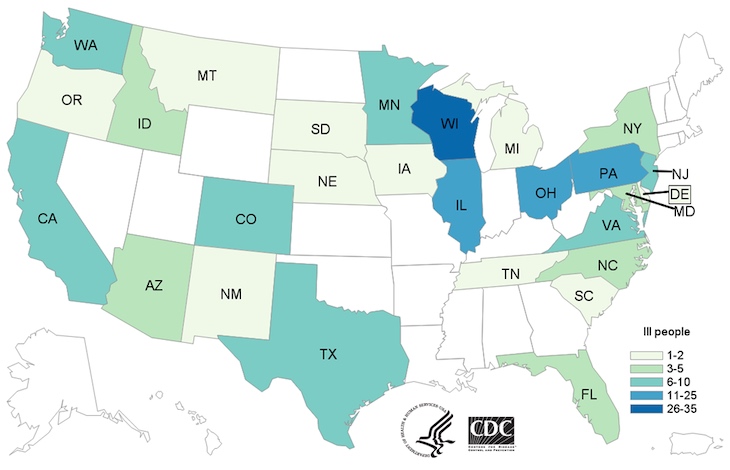The Salinas romaine E. coli O157:H7 outbreak is declared over by the Centers for Disease Control and Prevention (CDC), after sickening 167 people in 27 states. That is an increase of 29 more patients and two more states since the last outbreak update on December 19, 2019.
Eighty-five people were hospitalized, 15 people developed hemolytic uremic syndrome (HUS), a type of kidney failure, and there were no deaths. The CDC is no longer telling people to avoid romaine lettuce from the Salinas Valley growing region in California, but the growing season is over in that area until later this year. Once again, no specific grower or producer was named in this outbreak, although several recalls of products were issued.

The case count by state is: Arizona (4), California (8), Colorado (6), Delaware (1), Florida (4), Iowa (1), Idaho (4), Illinois (15), Maryland (5), Michigan (2), Minnesota (7), Montana (1), North Carolina (3), Nebraska (2), New Jersey (9), New Mexico (2), New York (3), Ohio (12), Oregon (1), Pennsylvania (21), South Carolina (1), South Dakota (1), Tennessee (1), Texas (6), Virginia (6), Washington (6), and Wisconsin (35). Illness onset dates ranged from September 20, 2019 to December 21, 2019. The patient age range is from less than 1 year to 89 years. Of 165 people who gave information to the government, 52% were hospitalized, including 15 people who developed HUS.
Information from PulseNet, the national sub typing network of public health laboratories, was used to identify people sickened in this outbreak. Whole genome sequencing (WGS) showed that bacteria isolated from patients was closely related genetically. That means that people in this outbreak were likely to share a common source of infection.
In addition, whole genome sequencing proved that this outbreak was caused by the same strain of E. coli O157:H7 that caused outbreaks linked to leafy greens in 2017 and to romaine lettuce in 2018.

If you or a loved one has been diagnosed with an E. coli O157:H7 infection or HUS, you can contact attorney Fred Pritzker for help by calling 1-888-377-8900 or 612-338-0202.
Romaine lettuce harvested from the Salinas, California growing region is the likely source of this outbreak. Ill persons were interviewed and asked questions about what they ate the week before they got sick. Eighty-three percent of people interviewed said they ate romaine lettuce, which is significantly higher than the results from a survey taken among healthy people.
In addition, the Maryland Department of Health found the outbreak strain of E. coli O157:H7 in an unopened package of Ready Pac Bistro Chicken Caesar salad taken from an ill person’s home in that state. And the Wisconsin Department of Health Services found the outbreak strain in an unopened bag of Fresh Express Leafy Romaine, also taken from an ill person’s home in that state. The Salinas Valley growing region in California was the main source of the romaine lettuce in both products.
The contaminated romaine lettuce from Salinas is no longer available for sale, as the growing season ended in November 2019. As of January 15, 2020, this Salinas romaine E. coli O157:H7 outbreak appears to be over.
Symptoms of an E. coli O157:H7 include a mild fever, vomiting, severe and painful stomach and abdominal cramps, and diarrhea that is bloody and watery. Symptoms of HUS include little urine output, bleeding from the nose and mouth, pale skin, lethargy, and unexplained bruises.




